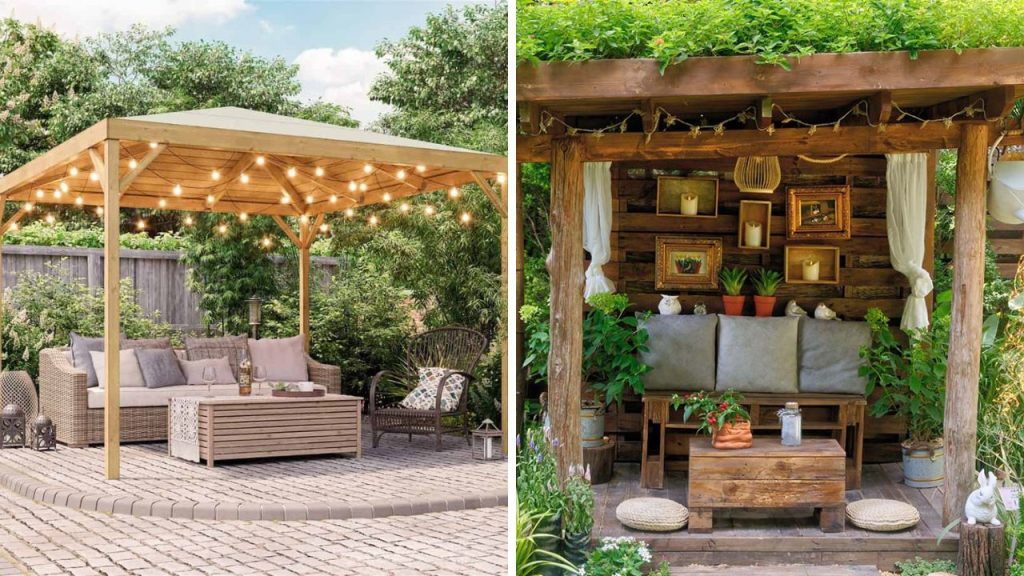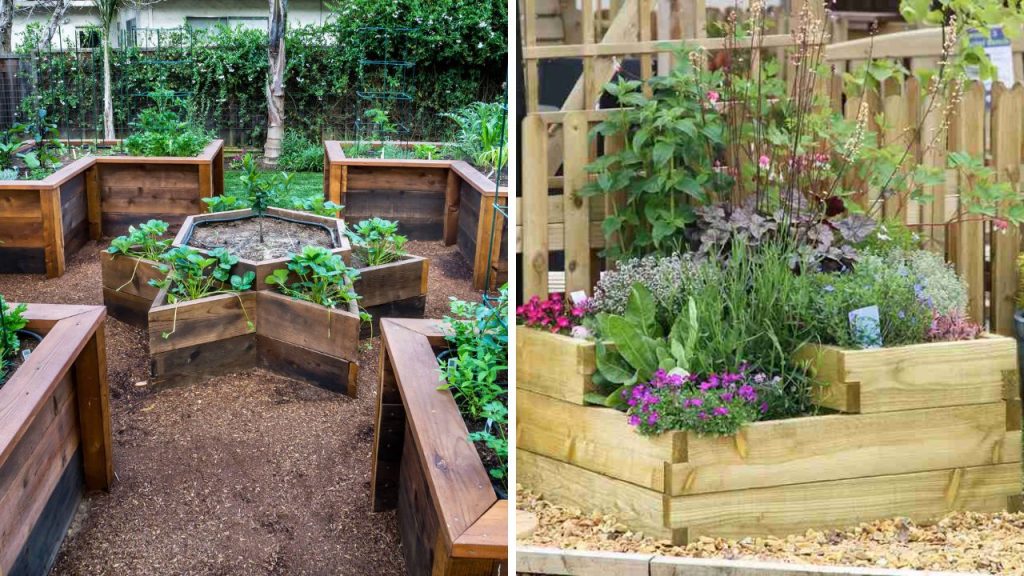Creating a beautiful outdoor pathway is one of the simplest ways to enhance your backyard, garden, or front yard. Stepping stones can bring a practical yet charming touch to any landscape, guiding visitors through your space while complementing your garden’s aesthetic. Whether you’re aiming for a natural, rustic feel or a sleek, modern design, there’s a stepping stone idea perfect for your outdoor space. Here are 17 ideas that will inspire your next outdoor project.
1. Mosaic Stepping Stones
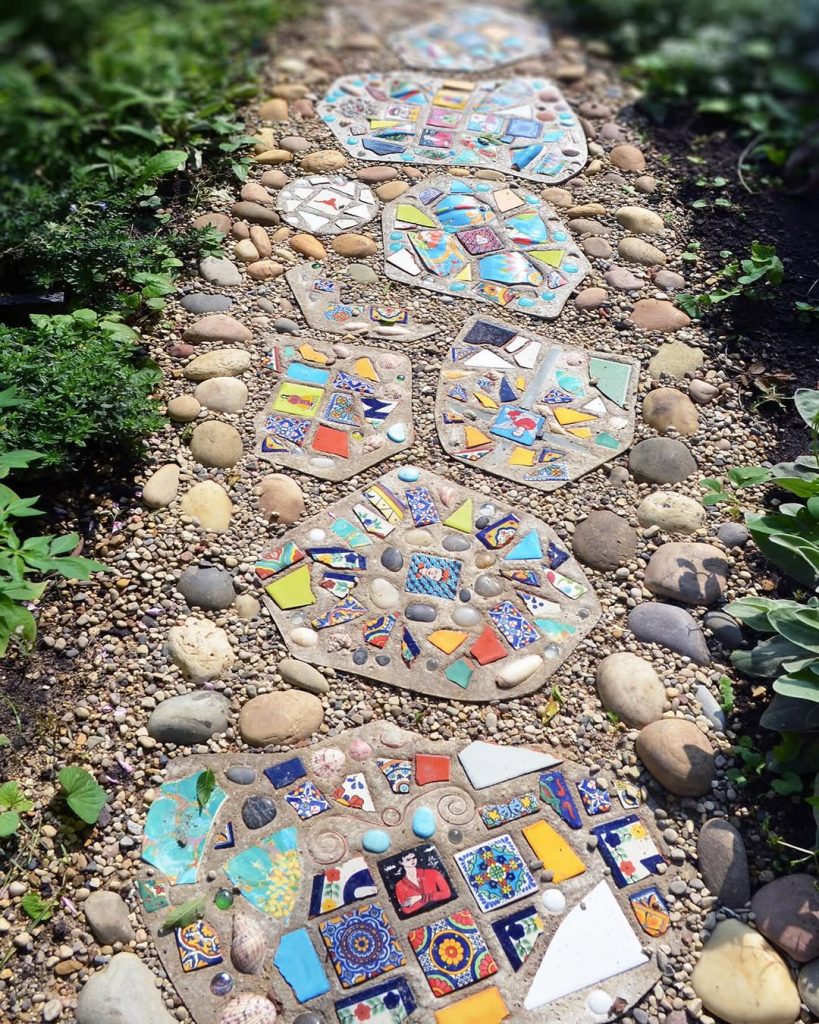
Mosaic stepping stones can add a colorful and artistic touch to your garden or pathway. These stones typically feature an intricate design made from various materials such as glass, stone, or even ceramic tiles. The designs can range from geometric patterns to floral motifs, offering a personalized look that truly reflects your style.
To create a mosaic stepping stone, you can use a pre-made stepping stone mold or create your own. Once you’ve poured the concrete, arrange the mosaic pieces before the stone hardens. The beauty of this idea is that you can choose any color or design that suits your outdoor aesthetic.
These mosaic stones can be scattered randomly for a playful look or arranged in a more uniform pattern for a more cohesive design. Either way, they will add a vibrant pop of color and a touch of artistry to your garden. They can even become a focal point, making them perfect for areas where you want to draw attention, like near flower beds or along garden borders.
2. Rustic Natural Stone Pathway
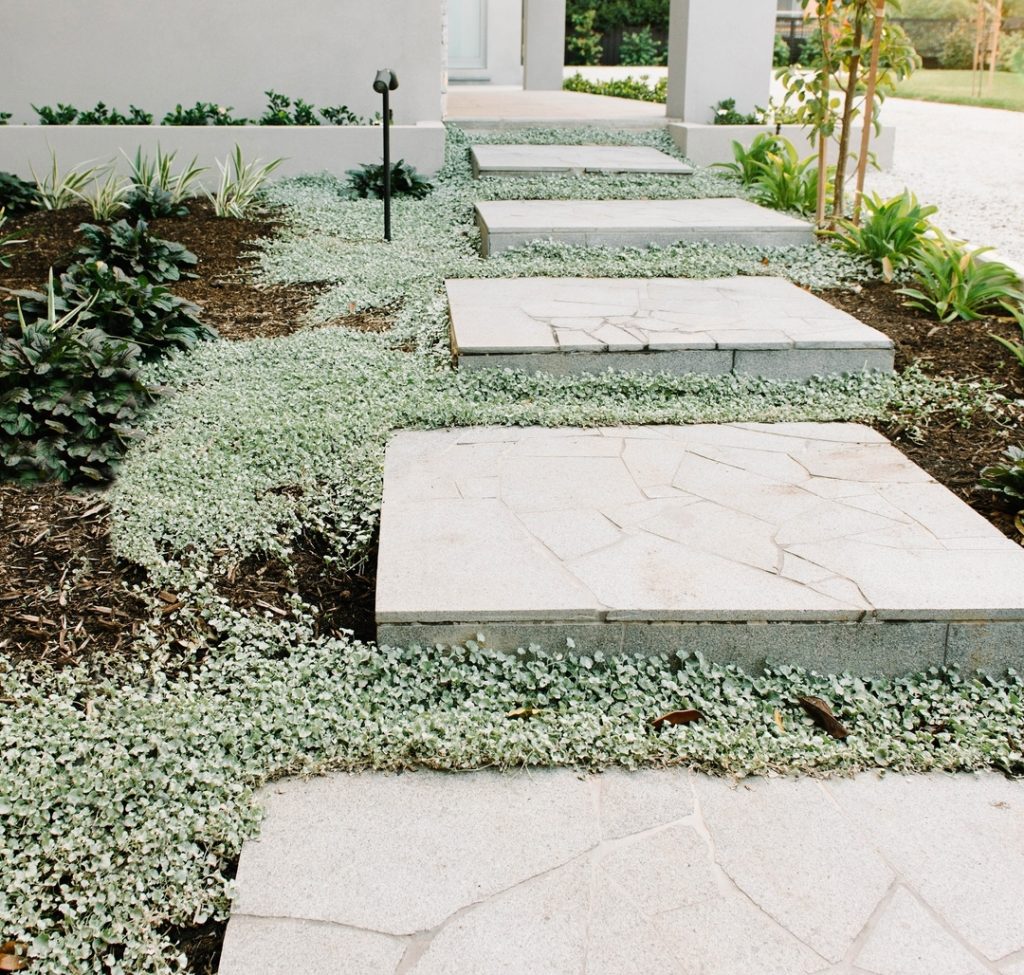
For a more natural and earthy feel, opt for a rustic stone pathway. Using uncut, irregular stones gives your garden an organic, rustic charm. These stones can be sourced locally, adding a layer of authenticity to your outdoor space.
When laying these stones, leave small gaps between them to allow grass or ground cover to grow through. This not only enhances the natural look but also provides a soft, green texture underfoot. To add extra interest, mix in different sizes of stones to create a more dynamic and textured pathway. The rough edges of the stones contrast beautifully with the delicate greenery, making them perfect for gardens with a wild or untamed feel.
This type of stepping stone pathway works well in both large and small spaces, and it’s perfect for anyone looking to bring a little piece of nature into their yard. Plus, it’s relatively easy to install yourself, making it a great DIY project for outdoor enthusiasts.
3. Concrete Stepping Stones with Crushed Gravel
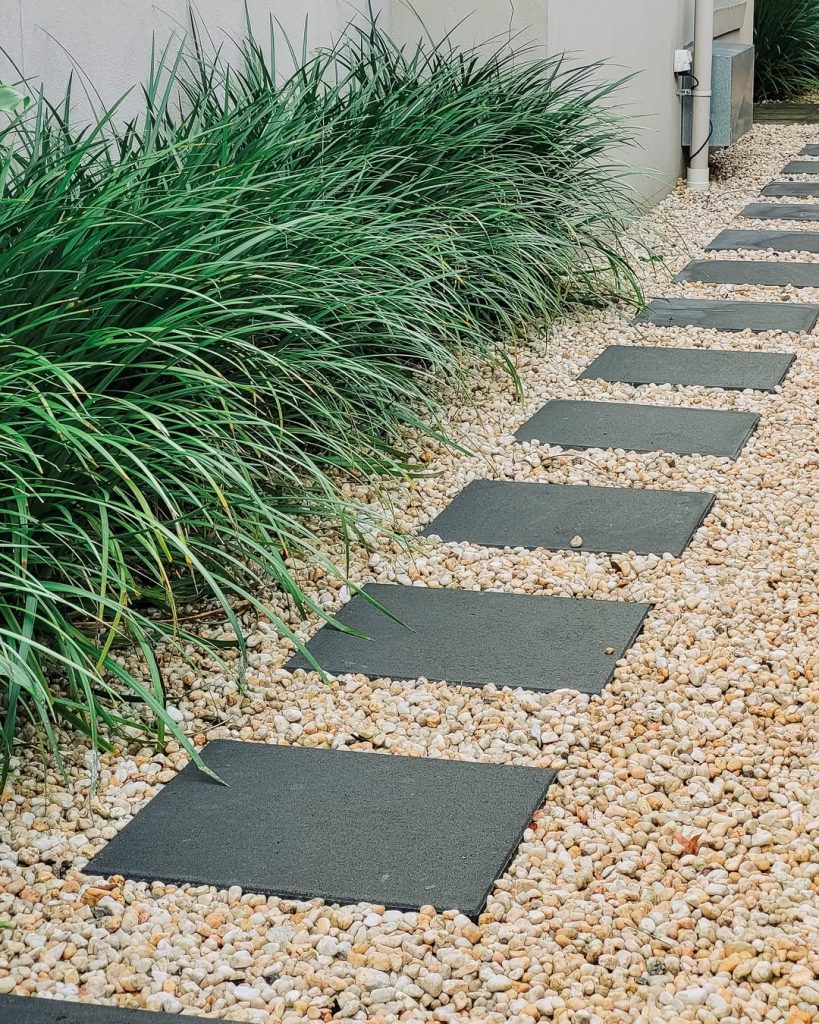
Concrete stepping stones are a classic option for a clean and structured look, but adding a touch of crushed gravel around them can take the design to the next level. The smooth, uniform surface of concrete contrasts beautifully with the rough texture of gravel, creating a chic, modern pathway.
To create this look, lay the concrete stones in a straight or curved line, and fill the space between them with crushed gravel. The gravel adds visual interest and makes the pathway feel more grounded. Choose gravel in neutral tones like gray or beige for a more understated look, or opt for a bold color to make the pathway stand out.
This design is particularly well-suited to modern gardens or minimalist outdoor spaces, where simplicity is key. The combination of concrete and gravel is not only stylish but also durable, making it perfect for high-traffic areas.
4. Wooden Stepping Stones
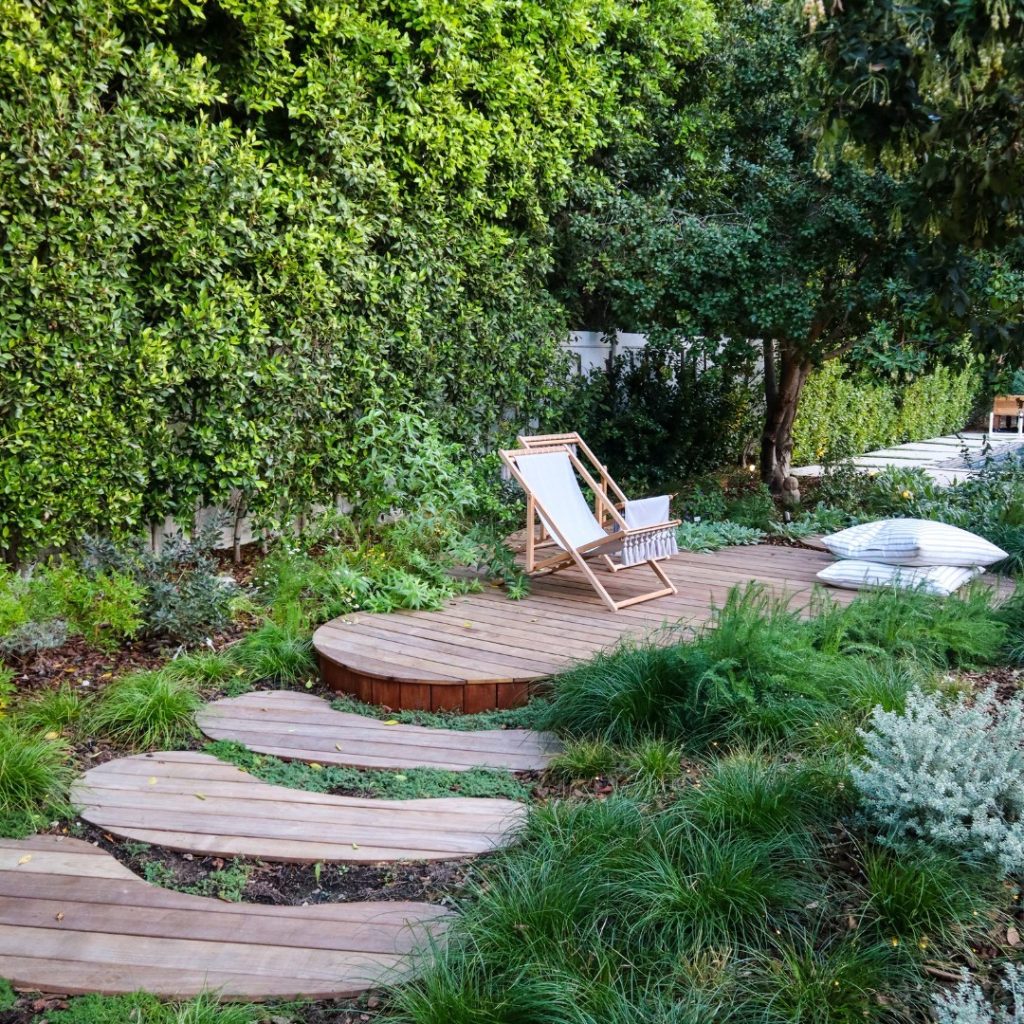
For a rustic, woodland-inspired pathway, wooden stepping stones are a fantastic choice. Using large slices of wood or logs can bring a natural, earthy vibe to your garden. The raw texture of the wood pairs beautifully with the vibrant green of the grass or surrounding plants.
To ensure the longevity of wooden stepping stones, treat the wood with a protective sealant to prevent decay. You can arrange the slices in a circular or linear fashion, depending on the size of your space. For added texture, incorporate moss or small plants around the edges of the wooden stones.
This design is perfect for woodland gardens or nature-inspired landscapes, offering a tranquil, calming atmosphere. The combination of natural materials adds warmth and texture to your outdoor space, making it feel welcoming and peaceful.
5. Pebble and Concrete Pathway
Source
If you’re looking for something that combines both texture and sleek design, a pebble and concrete pathway could be just the thing. Concrete stepping stones can be arranged with gaps in between, which are then filled with smooth pebbles. The contrast between the solid concrete and the soft, rounded pebbles creates an appealing, textured look that works well in various garden styles.
To install this pathway, lay the concrete stones and pour pebbles in between. Choose pebbles in a color that complements the tone of the concrete for a cohesive look. For a more contemporary style, opt for monochromatic stones, while multicolored pebbles will lend a more whimsical or boho touch.
This design is a great option for creating a functional yet stylish pathway, particularly in areas where you want a low-maintenance yet attractive walkway. The pebbles also help with drainage, making it ideal for places that experience a lot of rain.
6. Crushed Stone and Brick Combo
Source
For a classic yet elegant design, combining crushed stone with brick stepping stones creates a sophisticated pathway. The small crushed stones provide texture, while the bricks offer a more structured, uniform appearance. This mix is perfect for anyone who wants a pathway that’s both practical and visually appealing.
To achieve this look, create a brick path and fill the spaces between the bricks with crushed stone. You can choose a color of brick that complements your home’s exterior or the surrounding landscape. The crushed stone can be any color you prefer, with gray, white, or earthy tones being popular choices for this type of pathway.
This combination works well in more traditional or formal gardens but can also be adapted to fit modern or minimalist spaces. It’s easy to install, making it a fantastic option for DIYers.
7. Colorful Concrete Stepping Stones
Source
Add a pop of color to your garden with vibrant concrete stepping stones. These can be made in various colors, from bright reds and blues to more subtle pastels or earthy tones. Concrete is versatile and can be molded into virtually any shape or size, allowing you to get creative with your design.
To make colorful concrete stones, simply add pigment to your concrete mix before pouring it into molds. You can create a rainbow-colored pathway or opt for a monochromatic design with different shades of one color. Pairing these bright stones with greenery or flowers will create a lively and cheerful pathway that brings energy to your garden.
This idea is particularly great for families or those who enjoy fun, whimsical designs. The colorful stones can be arranged in a way that creates a playful, whimsical feel, or they can be more subtle to complement the surrounding plants.
8. River Rock Pathway
Source
River rocks are another excellent option for creating a natural and beautiful stepping stone pathway. The smooth, rounded stones add texture and interest, creating a soothing pathway that complements your outdoor living space. These stones come in a variety of colors and sizes, so you can mix and match to create a unique design.
Lay the river rocks in a linear fashion, or create a more irregular pattern to enhance the natural look of your garden. For a more modern feel, consider using large, uniform river rocks arranged in a straight line. Alternatively, a more rustic design can include smaller, multi-colored rocks scattered around the pathway.
The beauty of a river rock pathway is that it’s incredibly versatile and can be adapted to fit any style, from rustic to modern. The smooth texture of the rocks also makes the pathway easy to walk on, making it a practical choice for high-traffic areas.
9. Gravel Pathway with Metal Edging
Source
Gravel is one of the most popular materials for creating a simple and low-maintenance pathway, but adding metal edging can elevate the design. The sharp, clean lines of metal edging contrast beautifully with the soft, textured gravel, giving your pathway a sleek and modern look.
You can choose from a variety of metal edgings, such as steel, aluminum, or wrought iron, depending on the overall style of your garden. The metal edging not only helps define the boundaries of the path but also keeps the gravel contained, reducing the need for constant upkeep.
This design works particularly well in modern gardens or spaces with contemporary architecture, where the combination of metal and gravel creates a minimalist, chic pathway.
10. Stepping Stones with Succulent Borders
Source
Adding a touch of greenery around your stepping stones can enhance the overall look and feel of your garden. One way to do this is by planting succulents along the edges of your pathway. These low-maintenance plants thrive in a variety of climates and add texture and color to the path.
Succulent borders can be planted directly around the stepping stones or in between them. Their vibrant colors and unique textures create a contrast against the stone, making the pathway pop. Whether you choose small, compact succulents or larger varieties that spill over the edges, the combination of plants and stones creates a visually striking pathway.
This idea works wonderfully in dry, sunny areas where succulents thrive, but it can also add a touch of life to shaded spaces. It’s a fantastic option for anyone who loves plants but doesn’t want a high-maintenance pathway.
11. Stepping Stones with Lush Grass Gaps
Source
For a fresh, natural look, consider leaving gaps between your stepping stones and allowing lush grass to grow through. This design is ideal for anyone who enjoys the contrast between hard and soft landscaping materials. The green grass growing between the stones adds a vibrant and organic touch to the pathway.
When laying the stones, ensure there’s enough space for grass or ground cover to fill in naturally. If you prefer, you can also plant small flowers or creeping plants in the gaps for added color and variety. Over time, this pathway will blend beautifully with the surrounding landscape as the grass matures and fills in the spaces.
This idea works well in casual, traditional, or country gardens, where the goal is to create a natural, laid-back aesthetic. The grass-filled gaps will soften the look of the pathway, making it feel like an extension of your garden rather than a hard-edged feature.
12. Hexagonal Concrete Stepping Stones
Source
Hexagonal stepping stones are an excellent choice for adding a contemporary, geometric touch to your garden. These uniquely shaped stones form a visually striking pathway that’s both modern and dynamic. Their clean lines and angular shapes make them perfect for a structured, minimalist look.
To create a cohesive pathway, lay the hexagonal stones close together or with slight gaps between them. The repetitive pattern creates a sense of rhythm and movement as you walk along the path. You can choose a neutral color for the stones to blend seamlessly with your surroundings, or opt for a bold color to make a statement.
This design works well in modern or minimalist gardens, where symmetry and structure are key. It also pairs beautifully with contemporary garden furniture and landscaping elements, creating a sleek and polished outdoor space.
13. Stepping Stones with Pea Gravel Base
Source
Pea gravel is an affordable and low-maintenance material that pairs perfectly with stepping stones. The small, rounded gravel is easy to walk on and provides excellent drainage, making it a practical choice for outdoor pathways. When used as a base for stepping stones, pea gravel adds texture and visual interest while keeping the pathway looking neat and organized.
Lay the stepping stones on top of the pea gravel, ensuring they’re evenly spaced. The gravel creates a subtle contrast with the solid stones, enhancing their appearance without overpowering them. For added effect, choose stones in a color that complements the gravel, creating a cohesive design.
This idea works well in rustic or traditional gardens, where the focus is on creating a functional yet beautiful outdoor space. The pea gravel also helps with erosion control, making it ideal for sloped areas or places that experience heavy rainfall.
14. Upcycled Materials Stepping Stones
Source
For an eco-friendly and budget-friendly option, consider using upcycled materials to create your stepping stones. Old bricks, broken tiles, or even discarded concrete can be repurposed to form a unique and sustainable pathway. This idea allows you to get creative while giving new life to materials that would otherwise go to waste.
To create upcycled stepping stones, simply gather your materials and arrange them in a pattern that suits your design. You can mix and match colors and textures for a more eclectic look, or keep the materials uniform for a more cohesive design. Once arranged, pour concrete over the materials and let it set to form solid stones.
This concept is perfect for anyone who loves DIY projects and wants to add a personal touch to their garden while being environmentally conscious. The upcycled materials give the pathway a rustic, one-of-a-kind charm, and each stone tells a story.
15. Large Flat Stones with Moss
Source
For a serene, aged look, large flat stones paired with moss create a timeless pathway that blends seamlessly with your garden. The large stones provide a sturdy base, while the moss growing on them adds an air of antiquity and natural beauty.
To create this look, select large, flat stones with smooth surfaces, and place them at intervals in your garden. Between the stones, plant moss or let it naturally grow over time. The soft, green moss contrasts beautifully with the hard stone, adding depth and texture to the pathway.
This design is perfect for woodland or cottage gardens, where a soft, rustic charm is desired. Over time, the moss will spread, making the pathway look even more integrated into the landscape, as if it’s been there for years.
16. Stepping Stones in a Curved Pattern
Source
Straight pathways are common, but curved stepping stones add a more whimsical, natural element to your outdoor space. A curved pathway feels more organic, as it follows the natural lines of the garden, guiding visitors on a journey through the landscape. This design works particularly well in gardens with a flowing layout, where you want to evoke a sense of movement and discovery.
To create a curved pathway, arrange your stepping stones in a gentle, flowing pattern. You can either create a smooth, gradual curve or opt for sharper angles for a more dramatic effect. The key is to let the stones follow the natural flow of your garden, creating an inviting path that feels like it was designed with nature in mind.
This idea is perfect for anyone looking to create a pathway that feels less rigid and more in tune with the natural environment. The curved lines will lead guests on an exploration of your garden, making the journey just as enjoyable as the destination.
17. Stepping Stones with Water Feature
Source
Incorporating a water feature into your stepping stone pathway can transform your outdoor space into a tranquil oasis. Whether you choose a small fountain, a birdbath, or a bubbling creek, the sound of running water will enhance the peaceful atmosphere of your garden.
Place the stepping stones leading up to or around the water feature, creating a path that invites visitors to get closer to the serene sounds of nature. The pathway itself can be simple and unobtrusive, allowing the water feature to take center stage, or you can use the stones to create a more intricate design.
This idea works beautifully in Zen gardens or tranquil backyard retreats, where relaxation is key. The combination of water and stone creates a soothing, meditative experience for anyone walking along the path.
Conclusion
Stepping stones are a versatile and beautiful addition to any outdoor space. Whether you’re aiming for a rustic, natural look or something more modern and sleek, the options are endless. From mosaic stones to lush grass gaps, and from upcycled materials to water features, there’s a stepping stone pathway idea to suit every style and preference.
Not only do stepping stones serve as functional pathways, but they also enhance the aesthetic of your garden, bringing character and charm to your outdoor living space. So, whether you’re embarking on a DIY project or seeking inspiration for your next landscaping endeavor, these 17 ideas will help you create a stunning and welcoming pathway for years to come.
